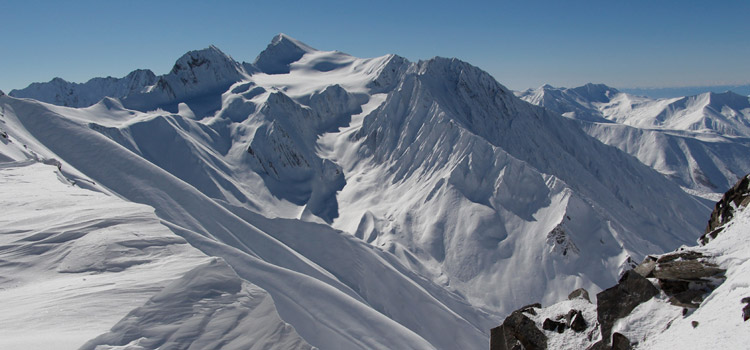
Every winter, more and more skiers / snowboarders head out of the ski areas and into the backcountry in search of a powder adventure. However, this beautiful natural environment of pristine snow slopes is not without danger; it presents potential hazards such avalanches that could cause serious harm to the backcountry enthusiast. In this uncontrolled environment, the threat of an avalanche should be kept in mind at all times; skiers and snowboarders must be aware of the risk involved when looking for a powder adventure. Only with appropriate training, good preparation and sound decisions, can they minimize the risk of being caught and injured by avalanches.
Snowpack structure
Snowfalls accumulate layers of snow on top of each other; the accumulation of these layers – from the ground up to the surface – forms what is called the snowpack.
Newly fallen snow is made of snow crystals that are representative of the distinct meteorological conditions during which the snow formed and was deposited. Once deposited, these crystals continue to change and undergo different kinds of metamorphism.
Several factors influence the metamorphic processes; the strength of a particular layer can either increase or decrease, depending on the metamorphic process that is taking place in that layer.
Factors that drive change in the snow layers include:
- meteorological conditions acting on the surface of the snowpack (temperatures, wind, humidity, rain, etc.)
- internal snowpack conditions affecting the sub-surface layers (variations in temperature, pressure, etc.).
All these factors are always present; therefore the layers are constantly changing. Weak layers create instability in the snowpack.
A few facts on avalanches
In the mountains, avalanches are a powerful force of nature that we cannot control. Every winter, people get caught, injured and sometimes killed by avalanches while skiing/ snowboarding off-piste, in the backcountry.
An avalanche occurs when the strength of the bonds that hold the snow together in the snowpack is overcome by an additional stress. Bonds in a particular weak layer then fracture, releasing the avalanche. The sources of stress that can overload a snowpack and cause fracture are called triggers.
Avalanches range in size from small “sluff” relatively harmless to large slides capable of destroying a village.
A lot of avalanches are triggered naturally; some common natural triggers are:
- Loading from new snow, from wind driven snow or from rain.
- Temperature changes and thawing caused by warm air and solar radiation.
However, the majority of avalanches that injure or kill backcountry recreationists are accidentally triggered by the victim or by a member of the same group.
Avalanche risk depends on terrain, snow stability and people. In other words, when the snowpack presents weak layers and is unstable, people can reduce the risk by avoiding avalanche terrain.
Assessing snow stability
Snow profiles help identify weak layers and where in the snowpack a failure might occur. A snow profile is done in a specifically dug snow pit, and consists of analyzing the different layers of the snowpack. The observations made in each layer, include: height of the layer within the snowpack, crystal type and size, hardness and moisture of the layer, temperature of the snow at regular intervals. In addition, various shear and compression tests are also performed in the snowpack. All this information put together help the observer evaluate the stability – or instability – of the snowpack at that particular site.
However, the snowy mountain environment is complex and dynamic, snow stability is affected by numerous factors and is variable from one slope to the next; data obtained from investigating the snowpack will not give a fully reliable estimate of the snow stability in the area.
In order to make a better assessment of the local avalanche danger, backcountry recreationists need to do additional research and gather other important information such as:
- Weather forecasts and avalanche conditions issued by regional agencies; this also has to be interpreted carefully, taking in consideration the location of the planned trip or slope; for example, at upper elevations snowfalls and winds are generally more intense, loading the snowpack differently and changing the conditions that are reported or forecasted for the valleys;
- Information on recent avalanche activity obtained from local and reliable sources (ski resorts, local experts, mountain guides, etc.);
- Natural signs and warnings observed in the surroundings. It is essential to recognize clear signs of unstable snow such as:
- evidence of avalanche activity (slopes with similar characteristics are likely to be unstable);
- cracks emanating from your skis, snowboard, snowshoes, etc;
- strange sounds and/or sensations, like snow collapsing under you and making a “whumpf” sound;
- breaking through heavy snow into an underlying layer of light snow.
Assessing snow stability is a complex process; not only does it involve gathering various elements of information from different sources, but also and most importantly, it requires combining these elements into an accurate interpretation of the snow stability. Unfortunately, there is no simple formula for that; to further their basic avalanche training, novice backcountry recreationists should gain experience assessing the snow stability with knowledgeable people that have acquired expertise in that field over many years of backcountry travel.
